Advertising displays have significantly evolved from traditional billboards and posters to dynamic digital screens. This transformation has maximized visibility and engagement, crucial in today’s fast-paced marketing environments. As brands compete for consumer attention, the innovation of transparent LED displays has emerged as a groundbreaking solution. These displays blend seamlessly into any setting, providing high-resolution, vivid imagery while maintaining the transparency of windows or glass surfaces, thus revolutionizing the way businesses attract and interact with their target audiences.
What are Transparent LED Displays?
Transparent LED displays are innovative digital screens that offer clear, vivid imagery while maintaining the transparency of the surface they are mounted on. These displays use LEDs mounted on a clear substrate, allowing light to pass through the gaps between the pixels, thereby preserving the see-through quality. Unlike traditional LED displays, which are opaque and block the background, transparent LEDs integrate seamlessly into glass windows or walls without obstructing views or natural light. This technology operates by emitting light only from the active pixels, making it less intrusive yet highly effective for advertising or informational displays in urban and retail environments.
Key Features of Transparent LED Displays
Transparent LED displays offer a unique combination of high-tech visibility and aesthetic integration, making them a preferred choice for modern advertising and architectural applications. The key feature of these displays is their transparency, which typically ranges from 60% to 90%. This allows natural light to filter through and maintains clear views through windows or glass partitions where they are installed. Such transparency notA only enhances visibility by blending digital content with the physical environment but also minimizes the visual obstruction typically associated with traditional displays, creating a more immersive experience for viewers.
Another significant advantage of transparent LED displays is their lightweight design. Unlike conventional LED panels that often require robust support structures, transparent LEDs are built with lighter materials and a more streamlined architecture. This makes them easier to install and integrate into existing glass facades or interiors without extensive modifications. They can be hung, mounted, or even retrofitted directly onto glass, reducing both the labor intensity and the structural impact on installation sites.
Energy efficiency is a further benefit of transparent LED displays. They consume significantly less power compared to traditional LEDs because they only light up the necessary pixels for displaying images or videos. This selective illumination, coupled with the inherent design that eliminates the need for backlighting, substantially reduces energy consumption. This not only lowers operating costs but also supports sustainability initiatives, aligning with modern ecological standards and promoting greener advertising solutions.
Benefits of Transparent LED Displays in Advertising
Transparent LED displays revolutionize advertising through their innovative design, seamlessly integrating into various environments without obstructing views. This adaptability allows businesses to use them in windows, on the facades of buildings, or even inside without sacrificing natural light or aesthetics. Their clear nature ensures that advertisements do not block the scenery or interior design, blending digital content into the physical world and engaging viewers in a dynamic, unobtrusive manner.
These displays enhance customer engagement by capturing attention with vivid, bright images and animations that can be seen clearly, even in direct sunlight. Their high brightness levels ensure that the content is visible and striking from a distance, drawing in viewers and making the advertising message unmissable. This is particularly effective in retail windows or outdoor settings where traditional displays might struggle with glare and visibility issues.
The innovative use of transparent LED displays allows advertisers to create a sense of high-tech sophistication and modernity. They provide a unique platform for creative and interactive ads, from showcasing products in action to integrating augmented reality features, thus heightening consumer interest and interaction. This enhanced engagement not only boosts brand visibility but also significantly increases the likelihood of converting viewers into customers.
Applications of Transparent LED Displays
Transparent LED displays have found diverse applications across various sectors, enhancing visibility and engagement wherever they are installed.
Retail Environments and Shopfronts:
In retail, these displays transform shopfront windows into vibrant advertising spaces. For example, high-end fashion brands use transparent LEDs to showcase runway clips or new collections while maintaining the transparency of their storefront. This not only attracts passersby but also creates an immersive shopping experience that blends digital content with physical products.
Corporate Buildings and Business Hubs:
Corporate entities use transparent LED displays in lobbies and facades to communicate with employees and visitors. These installations can display real-time company news, stock prices, or promotional content, all without disrupting the architectural aesthetics or blocking natural light.
Public Spaces and Event Venues:
Public venues such as airports, convention centers, and stadiums leverage these displays for both wayfinding and advertising. They provide crucial information without impeding views or natural aesthetics, enhancing the functionality of large, crowded spaces.
Design and Aesthetic Advantages
Transparent LED displays offer significant design and aesthetic advantages that can enhance architectural aesthetics dramatically. These displays integrate seamlessly into building facades, windows, and interiors without disrupting the structural design or aesthetics, preserving the architectural integrity while adding a dynamic visual layer. This ability to blend digital content with physical structures enhances not only the building’s appearance but also its functionality.
The flexibility in design and extensive customization options available with transparent LED displays allow architects and designers to tailor these solutions to any space, shape, or size. Whether curved, flat, or patterned, these displays can adapt to the specific design requirements of any project, offering creative freedom to enhance environmental aesthetics and user interaction.
The visual impact of transparent LED displays significantly affects brand perception by conveying modernity and innovation. Brands utilizing this technology are often perceived as forward-thinking and tech-savvy, which can elevate consumer engagement and brand loyalty. This blend of utility and aesthetics makes transparent LED displays a powerful tool in creating visually compelling and architecturally integrated advertising and informational solutions.
Conclusion
Transparent LED displays offer unmatched transparency, lightweight installation, and energy efficiency, enhancing visibility and engagement without disrupting architectural aesthetics. Businesses should consider this innovative technology to elevate brand perception and create immersive advertising experiences. Embrace the future of digital display solutions with transparent LED technology.







